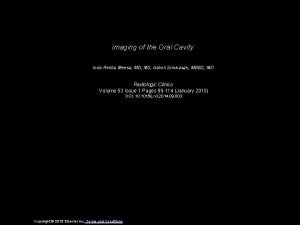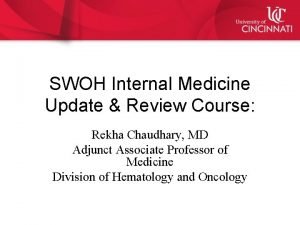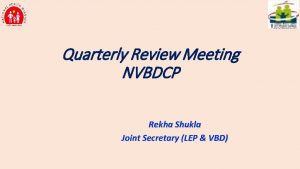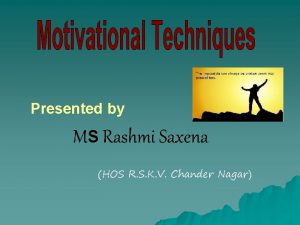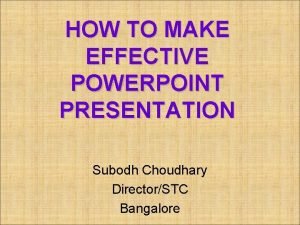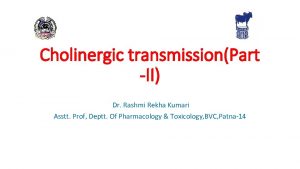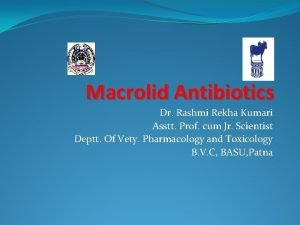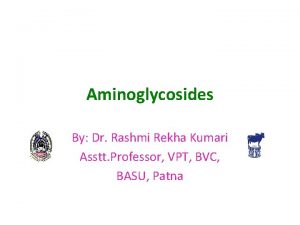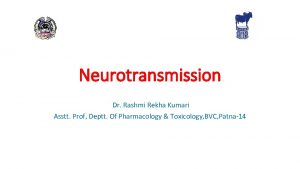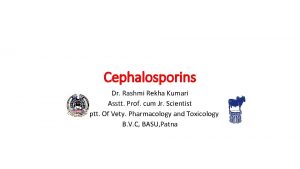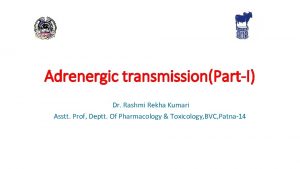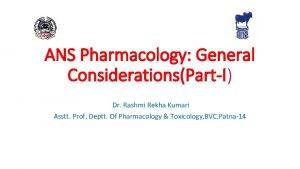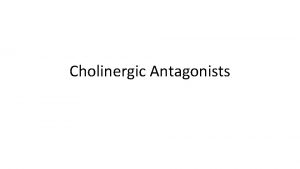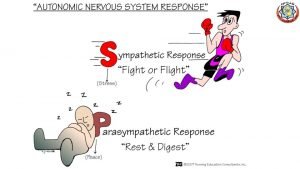Cholinergic transmissionPart I Dr Rashmi Rekha Kumari Asstt











- Slides: 11

Cholinergic transmission(Part -I) Dr. Rashmi Rekha Kumari Asstt. Prof, Deptt. Of Pharmacology & Toxicology, BVC, Patna-14

Cholinergic transmission ØNeurohumoral transmission either at synapse or neuroeffector junction in which acetylcholine act as a humoral agent(neurotransmitter) for transmission of action potential across the junction ØDale and his colleagues discovered its transmitter role in the 1930. ØThe different sites of cholinergic transmission are 1. Parasympathetic neuroeffector junctions(Post ganglionic parasympathetic fiber) 2. Autonomic ganglia (Preganglionic parasympathetic and Preganglionic sympathetic fiber) 3. Adrenal medulla (preganglionic parasympathetic) 4. Somatic myoneural junctions 5. Certain regions of CNS. 6. Post ganglionic sympathetic fiber to sweat gland


Synthesis, Storage, Release & Catabolism of Acetylcholine

ØCholine acetyl transferase catalyse the final step in synthesis of acetylcholine-The acetylation of choline with acetyl coenzyme A ØCholine acetyl transferase is synthesised in perikaryon and then is transported along the length of axon to its terminal ØAxonal terminal contain large amount of mitochondria, where acetyl Co. A is synthesised, ØCholine is taken up from extracellular fluid into axoplasm by active transport. ØThe final step in the synthesis occur within the cytoplasm. ØFollowing synthesis most of the Ach is sequestered in synaptic vesicle ØUptake of choline is rate limiting step in biosynthesis of Acetylcholine

ØTransport of choline from extracellular fluid to cytoplasm is inhibited by hemicholinium ØAch is packaged into synaptic vesicle at high concentration by carrier mediated transport( blocked by vesamicol) ØAch release occurs by Ca 2+- mediated exocytosis. At neuromuscular junction, one presynaptic nerve impulse releases 100 -500 vesicles. Ø At NMJ, Ach acts on nicotinic receptors to open cation channel, producing a rapid depolarisation(end plate potential), which normally produce an action potential in muscle fiber ØTransmission at other ‘fast’ cholinergic synapses(e. g. ganglionic) are similar

CAT: Choline acetyltransferase

Acetylcholine esterase(Ach. E) ØAfter serving the transmitter function, ACh within the junctional space is rapidly inactivated by hydrolysis by a specific enzyme, acetylcholine esterase (ACh. E). ØACh. E is present in cholinergic nerves, autonomic ganglia and neuromuscular & neuroeffector junctions. ØAch. E is bound to the basement membrane that lies between the pre and post synaptic membrane.

ØAt fast cholinergic synapse (neuromuscular and ganglionic synapse) but not at slow ones (smooth muscle, gland, heart etc) the released Ach is hydrolysed by ACh. E very rapidly( within 1 ms), so that it act very briefly. ØA somewhat similar enzyme, butyrylcholinesterase (a pseudocholinesterase) is present in serum and other body tissues. It is primarily synthesized in the liver and its likely vestigial physiological function is the hydrolysis of ingested esters from plant sources.

Differences between two types of cholinesterases (i) Distribution Acetylcholinesterase Butyrylcholinesterase (True Cholinesterase) (Pseudo-cholinesterase) All cholinergic sites, RBCs, gray Plasma, liver, intestine, white matter (ii) Hydrolysis ACh Methacholine Benzoylcholine Butyrylcholine Very fast (in microseconds) Slower than ACh Not hydrolyzed Slow Not hydrolyzed Hydrolyzed (iii) Inhibition More sensitive to Physostigmine More sensitive to organophosphates (iv) Function Termination of ACh action Hydrolysis of ingested esters.




